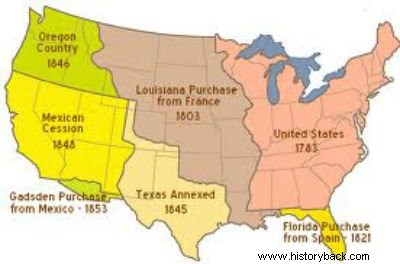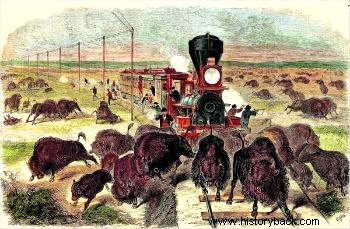The March to the West in the United States was characterized by territorial expansion towards the Pacific, in the second half of the 19th century.
This growth was achieved through wars, purchases of territory and laws that favored internal migration.
Origin:wars, territory purchases and migration laws

Map of American territorial expansion to the West.
With population growth, the American population needed land to farm.
Furthermore, after the independence of the Thirteen Colonies, the American government was concerned about the presence of Spaniards and French within the same territory. So he promoted a series of land purchases such as Louisiana (1803), obtained from France and Florida, bought from Spain.
Read more about the Independence of the United States.
Texas also obtained its independence from Spain in 1836. Later, it would be incorporated after the war with Mexico by President Polk in 1845, due to the possibility of it being invaded again by Mexico.
Any attack on American settlers by Indians or Mexicans was seen as aggression. Thus, the US Federal Army was involved in struggles with these peoples in order to guarantee the American occupation of these lands.
Taking advantage of the fragility of the new country, Mexico, which was involved in infighting after independence, the United States declared war on them. With the American victory, the current states of Nevada, Utah, Arizona, California, New Mexico, Colorado and Wyoming were incorporated.
Expansion and Settlement
In addition to the economic appeal, the Americans, since their founding, have always believed themselves to be the people chosen by God to regenerate the institutions of decaying Europe.
Thus, the doctrine of Manifest Destiny stated that it was the obligation of Americans to civilize and occupy these new spaces.
In order to encourage people to settle them, the government enacts the Homested Act (Population Law) in 1862. This law provided for the donation of a plot of land to Americans over 21 years of age and these could become owners of the same if they kept it cultivated for five years.
Likewise, from 1849 onwards, the west coast would definitely be occupied by Americans. During the so-called Gold Rush, the current state of California became the new “American dream” of enrichment and prosperity. It is estimated that 300,000 people, including Americans and foreigners, arrived there between 1849-1855, expelling the native population.
Consequences of the March to the West

Ernest Grislet, "The Wild West:Buffalo Killing on the Kansas-Pacific Railroad Line. Published in Frank Leslie's Illustrated Journal, June 3, 1871.
- Demographic growth,
- economic development based on smallholdings and creation of an internal market,
- the certainty – on the part of the Americans – that the Anglo-Saxons belonged to a culture superior to the Hispanics and Indians, and therefore it was legitimate to declare war on them,
- extermination of indigenous populations and confinement of tribes on reservations,
- indiscriminate killing of buffalo herds, the main livelihood of several indigenous tribes, which would also contribute to weakening these peoples,
- increasing differences between the colonies of the North and the South that adopted different economic models and that would culminate in the Civil War.
